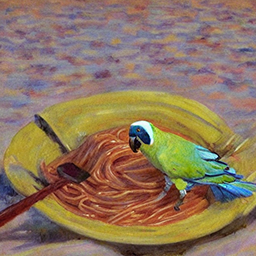Runs the official Stable Diffusion v1.4 release on Huggingface in a GPU accelerated Docker container.
./build.sh run 'An impressionist painting of a parakeet eating spaghetti in the desert'The pipeline uses the full model and weights which requires 8GB+ of GPU RAM. On smaller GPUs you may need to modify some of the parameters. It should take a few seconds to create one image.
Since it uses the official model, you will need to create a user access token
in your Huggingface account. Save the
user access token in a file called token.txt and make sure it is available
when building the container.
The pipeline is managed using a single build.sh script. You must
build the image before it can be run.
Make sure your user access token is saved in a file called
token.txt. The token content should begin with hf_...
To build:
./build.sh build # or just ./build.shTo run:
./build.sh run 'A high tech solarpunk utopia in the Amazon rainforest'Some of the options from txt2img.py
are implemented for compatibility:
--prompt [PROMPT]: the prompt to render into an image--n_samples [N_SAMPLES]: number of images to create (default 1)--H [H]: image height in pixels (default 512)--W [W]: image width in pixels (default 512)--scale [SCALE]: unconditional guidance scale (default 7.5)--seed [SEED]: RNG seed for repeatability (default is a random seed)--ddim_steps [DDIM_STEPS]: number of sampling steps (default 50)
Other options:
--half: use float16 tensors instead of float32 (default float32)--skip: skip safety checker
These commands are both identical:
./build.sh run 'abstract art'
./build.sh run --prompt 'abstract art'Set the seed to 42:
./build.sh run --seed 42 'abstract art'Options can be combined:
./build.sh run --scale 7.0 --seed 42 'abstract art'On Windows, if you aren't using WSL2 and instead use MSYS, MinGW, or Git Bash,
prefix your commands with MSYS_NO_PATHCONV=1 (or export it beforehand):
MSYS_NO_PATHCONV=1 ./build.sh run --half --prompt 'abstract art'The model and other files are cached in a volume called huggingface.
The images are saved as PNGs in the output folder using the prompt text. The
build.sh script creates and mounts this folder as a volume in the container.

